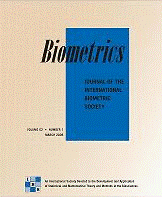 | |
| Discipline | Statistics |
|---|---|
| Language | English |
| Edited by | Alan Welsh, Debashish Ghosh, Mark Brewer, Geert Molenberghs |
| Publication details | |
| History | 1945–present |
| Publisher | |
| Frequency | Quarterly |
| 1.701 (2021) | |
| Standard abbreviations | |
| ISO 4 | Biometrics |
| Indexing | |
| CODEN | BIOMB6 |
| ISSN | 0006-341X (print) 1541-0420 (web) |
| LCCN | 49001784 |
| JSTOR | 0006341X |
| OCLC no. | 5898885 |
| Links | |
Biometrics is a journal that publishes articles on the application of statistics and mathematics to the biological sciences.[1] It is published by the International Biometric Society (IBS).[2] Originally published in 1945[3] under the title Biometrics Bulletin, the journal adopted the shorter title in 1947.[4] A notable contributor to the journal was R.A. Fisher, for whom a memorial edition was published in 1964.[5] In a survey of statistics researchers' opinions, it was ranked fifth overall among 40 statistics journals, and it was second only to the Journal of the American Statistical Association in the ranking provided by biometrics specialists.[6]
YouTube Encyclopedic
-
1/3Views:395 8905 36612 267
-
How Do My Fingerprints Form?
-
Signal processing technology extracts information from image, sound, and biometric signals #DigInfo
-
Video Games and the Future of Learning (Jan Plass and Bruce Homer)
Transcription
If you have fingers, I’m guessing you've fingerprints. Those fingerprints are what make you unique, right? That’s why all the smart criminals on TV wear gloves. I mean, not even identical twins have the same prints. But a lot of the way that fingerprints form is, as it turns out, controlled by genetics. Even though a lot of people think of fingerprints as being random, the main pattern, which is the general shape that your print makes, is really a product of your genes. There are three basic classes of fingerprints: There are whorls, which mostly look like swirls or circles; loops, which are just curvy lines that start and end on the same side of the finger; and arches, which start and end on opposite sides of the finger. Now, genetics don’t directly control which of these patterns appear on each finger. But they do affect the factors that lead to the different shapes -- like the symmetry of the finger’s surface. See, between the sixth and eighth week of a fetus’ development, a fetus starts to get these extra thick pads on its fingers and palms and feet, called volar pads. These pads begin to appear when a special kind of stem-cell tissue swells beneath the existing layers of skin. This tissue is called mesenchyme, and it eventually forms connective tissues like skin and blood vessels. In humans, these volar pads don’t stick around for long. Around week ten, the pads stop growing, while the hands continue to grow. For the next five weeks, then, the volar pads smooth out into the hands and feet we’re all familiar with. But what they look like as they disappear is largely controlled by genes, which affect both how the hand grows and when exactly the fingerprints begin to form. And the results are not always symmetrical or uniform. For instance, a finger might grow faster on one side than the other, leading to a volar pad that’s slanted to the left or right like a tiny ramp. If the primary ridges, which are the earliest precursors of the ridges in fingerprints, form along that slant, they’ll make a loop. But if the volar pad isn’t slanted when the ridges show up, then they’ll form a more symmetrical pattern. Research has found that if the pad is flat, but still prominent, the ridges will turn into a whorl. But if the pad has mostly disappeared, though, then they’ll form an arch. Since these patterns are informed by genetics, the patterns often run in families. BUT! There are smaller intricacies within the fingerprints -- which the experts just call minutiae -- that do vary from person to person, even within families. And we’re not totally clear on how that part works, but research suggests that these finer points are influenced by environmental factors, including the actual position of the fetus in the womb, whether it’s touching the amniotic sac, and even the density of amniotic fluid. Together, these things can tweak the overall pattern, like the number of ridges, or where they converge on your finger. Even in identical twins, then, the patterns on each of their fingers may match up, but their prints aren’t exactly the same. So not only are your fingerprints unique -- they can also tell you a lot about how you developed in the womb. Thanks for asking, and thanks to all of our patrons on Patreon who make SciShow possible through their monthly contributions. If you like Quick Questions and SciShow and want to help us keep making more videos like this, you can go to Patreon.com/SciShow!
References
- ^ JSTOR entry on biometrics
- ^ Biometrics homepage Archived June 25, 2007, at the Wayback Machine
- ^ Biometrics Bulletin JSTOR Coverage
- ^ Biometrics, Vol. 3, No. 1, Mar., 1947 Page 53
- ^ Biometrics, Vol. 20, No. 2, In Memoriam: Ronald Aylmer Fisher, 1890-1962, Jun., 1964
- ^ Theoharakis, Vasilis; Skordia, Mary (2003), "How do statisticians perceive statistics journals?", The American Statistician, 57 (2): 115, doi:10.1198/0003130031414, S2CID 122626806.
External links
- Official website
- Publisher website (Wiley)
- International Biometric Society (IBS)
- Biometry by m2sys.com
